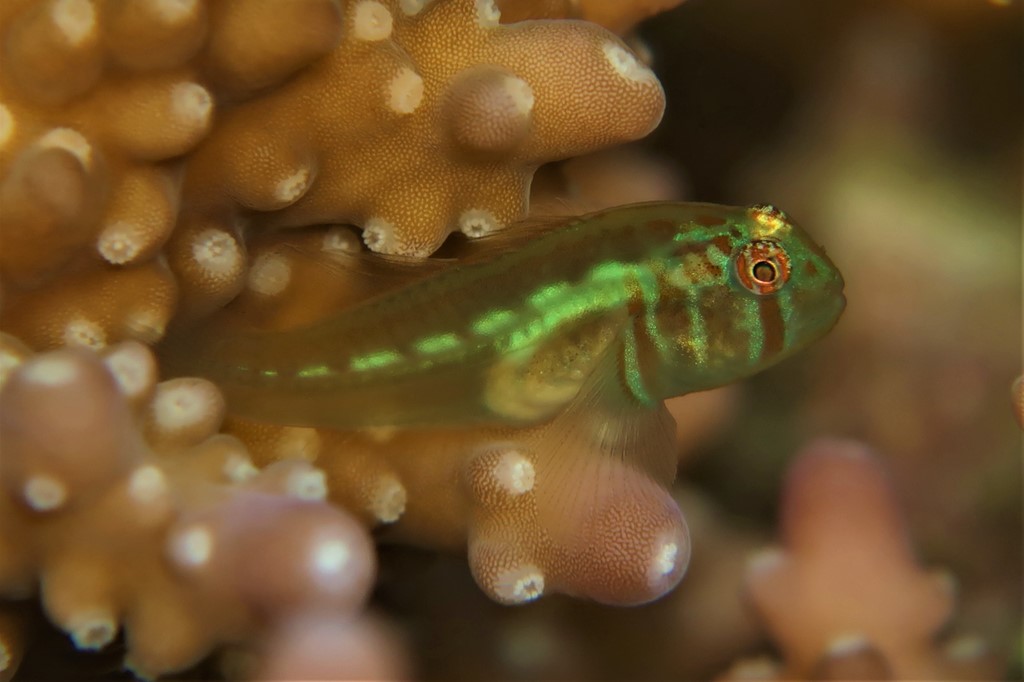GOBIODON HISTRIO - (VALENCIENNES, 1837)
Picture courtesy of: Alain Daoulas
Maori coralgoby, Broad-banded goby, Broad-barred goby, Broad-barred maori goby, Broad-barred coralgoby, Maori coral goby, Blue-spotted coral goby, Green clown goby, Benisashikobanhaze, ベニサシコバンハゼ, 宽纹叶鰕虎鱼,
Synonymes
Gobiodon verticalis (Alleyne & MacLeay, 1877)
Gobius histrio (Valenciennes, 1837)
---------------------------
Description
Dorsal spines (total): 6-7; Dorsal soft rays (total): 10-11; Anal spine: 1; Anal soft rays: 9; Pectoral fin rays: 19-21. Absence of scales; Complete pelvic fin frenum and basal membrane; Head profile steep to rounded; A groove on underside of head bent to one side at anterior end. First dorsal fin low and rounded. Depth of body at level of pelvic fins: 2.2-2.7 in SL. Max. length: 3.5 cm TL. Depth range: 0 - 30 m, usually: 2 - 15 m.
Color
Head and body green, bluish ventrally; Head with 3-4 broad orange to reddish bars, and blackish to dark blue spot at upper rear corner of opercle; 2-6 irregular red to orange-red stripes on sides (stripes may break up into spots or be absent from lower half of body; In northern Red Sea form, the red stripes on body and head form loops and rings); Fins greenish, paler toward margins; Dorsal- and anal fin bases with pale greenish to yellowish green band, bordered above with fine red spots, which may coalesce in first dorsal fin to form red edge on the pale band.
Etymology
Gobiodon: from Latin, gobius = gudgeon + from Greek, odous = teeth. Referring to pair of posterior canines near symphysis of lower jaw of Gobiodon heterospilos.
histrio: from Latin, histrio = related with actors, an actor, player. Coined by Kuhl & van Hasselt, referring (per Valenciennes) to its resemblance to the Sargassum Fish, Lophius (now Histrio) histrio, or referring to its gaudily striped pattern.
Original description: Gobius histrio Valenciennes, 1837 - Type localities: Bantam, Java, eastern Indian Ocean; Tongatapu, Tonga Islands, South Pacific.
Distribution
Red Sea, Indo-West Pacific: Andaman Islands, east to Samoa, north to Philippines, south to northern Australia and New Caledonia.
Head and body green, bluish ventrally; Head with 3-4 broad orange to reddish bars, and blackish to dark blue spot at upper rear corner of opercle; 2-6 irregular red to orange-red stripes on sides (stripes may break up into spots or be absent from lower half of body; In northern Red Sea form, the red stripes on body and head form loops and rings); Fins greenish, paler toward margins; Dorsal- and anal fin bases with pale greenish to yellowish green band, bordered above with fine red spots, which may coalesce in first dorsal fin to form red edge on the pale band.
Etymology
Gobiodon: from Latin, gobius = gudgeon + from Greek, odous = teeth. Referring to pair of posterior canines near symphysis of lower jaw of Gobiodon heterospilos.
histrio: from Latin, histrio = related with actors, an actor, player. Coined by Kuhl & van Hasselt, referring (per Valenciennes) to its resemblance to the Sargassum Fish, Lophius (now Histrio) histrio, or referring to its gaudily striped pattern.
Original description: Gobius histrio Valenciennes, 1837 - Type localities: Bantam, Java, eastern Indian Ocean; Tongatapu, Tonga Islands, South Pacific.
Distribution
Red Sea, Indo-West Pacific: Andaman Islands, east to Samoa, north to Philippines, south to northern Australia and New Caledonia.
Biology
Solitary or in pairs, also found in reef crests and lagoons. Facultative air-breathing; Found among branches of Acropora nasuta (Munday, 2000). On the Great Barrier Reef, this coral species has two color morphs - one with blue tips, the other with brown tips. Gobiodon histrio often prefers the 'blue-tip' variety, with one breeding pair sheltering within a single coral colony. Feeds on a range of small invertebrates. Capable of changing sex during their life. Remarkably, they can change sex in both directions, from male to female (protandrous), and from female to male (protogynous). Aquarium fish.
Similar species
Gobiodon aoyagii (Shibukawa, Suzuki & Aizawa, 2013) - Reported from Western Pacific: Japan, Philippines, Australia, Papua New Guinea and East Indies.
Gobiodon erythrospilus (Bleeker, 1875) - Reported from New Caledonia - Link to the species (here).
Last update: 6, september 2024
Solitary or in pairs, also found in reef crests and lagoons. Facultative air-breathing; Found among branches of Acropora nasuta (Munday, 2000). On the Great Barrier Reef, this coral species has two color morphs - one with blue tips, the other with brown tips. Gobiodon histrio often prefers the 'blue-tip' variety, with one breeding pair sheltering within a single coral colony. Feeds on a range of small invertebrates. Capable of changing sex during their life. Remarkably, they can change sex in both directions, from male to female (protandrous), and from female to male (protogynous). Aquarium fish.
Similar species
Gobiodon aoyagii (Shibukawa, Suzuki & Aizawa, 2013) - Reported from Western Pacific: Japan, Philippines, Australia, Papua New Guinea and East Indies.
Gobiodon erythrospilus (Bleeker, 1875) - Reported from New Caledonia - Link to the species (here).
Last update: 6, september 2024
